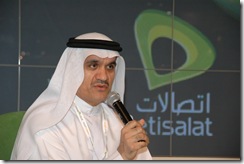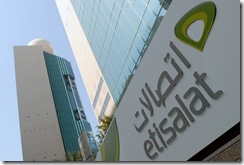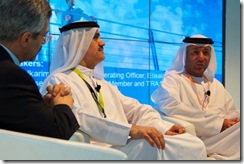The man who has been heavily involved in engineering Etisalat’s strategic development over the past 10 years believes the telecom sector is at an inflection point where the entrance of new players into the telecom sphere is resulting in the future of the sector becoming more of an unknown quantity – a ‘shared uncertainty’. Ahmad Julfar, Etisalat’s group chief operating officer, believes more business opportunities than threats exist in the evolving world of telecom, with his focus being on ensuring Etisalat delivers on those prospects
Julfar, an Etisalat stalwart, says the telco needs to remain as dynamic in its outlook as the telecom sector has been of late in order to continue succeeding
Etisalat’s ongoing due diligence of Zain Group as part of its proposed acquisition of a majority stake in the Kuwait-listed operator forms part of the UAE operator’s strategic assessment that scale and scope are instrumental to its long-term success. According to Ahmad Julfar, operators around the world and in emerging markets in particular are reviving their inorganic expansion efforts as they pursue the remaining pockets of growth.
“M&A activity will resume its pace in 2011,” Julfar predicts. “There is an expectation that multiple ‘megadeals’ in the form of acquisitions or mergers between large group operators will occur,” he adds. The evidence of this is already plain to see with VimpelCom looking to tie up with Orascom Telecom Holding and Weather Investments; Telefonica having increased its stake in China Unicom; and Etisalat looking to acquire a majority stake in Zain Group.
“The potential for consolidation among major group operators is significant,” Julfar asserts, and while this is partly driven by increased competition in domestic markets, it is also as a result of operators looking to find and offer value to their subscribers.
About a year ago Etisalat reported it had added its 100 millionth subscriber, from operations across 18 markets, and that the ambition remained to pursue a larger number of customers in all markets it operated in. Quoting Etisalat chairman Mohammad Omran, Julfar tells of how it was difficult for the telco to achieve its first million subscribers, but how once that milestone had been achieved, the addition of the second million end-users was substantially easier. He believes the same philosophy applies today, but rather than referring to the addition of the next million subscribers, Julfar believes the same ideology can be applied to the addition of the next hundred million subscribers.
Understanding the end-customer and building a lasting, beneficial relationship with subscribers is a development that has moved into the focus of the majority of operators in the Middle East and Africa. The competitive requirement to provide customers with unique, interactive experiences and provide value added services is growing all the while, with pressure to evolve also being applied from outside the traditional parameters of the telecom sector.
As reported by Comm. in its issue 22, Michael Seeger, head of Customer Insight and Experience for the MEA at Nokia Siemens Networks, believes that new competitors entering the traditional telecom space are placing significant pressure on telcos, making it imperative that service providers understand their end-users and satisfy their service requirements efficiently and effectively.
Seeger said benefits that accrue to service providers by fostering a closer relationship with customers can be categorised under three main areas:
- Enhancement of customer experience
- Need to drive new revenue streams
- Survival need to improve operational efficiency
“The transformation that is happening in the telecom sector, and the market dynamics in the Middle East, are such that new core sources of revenue and growth are occurring,” Julfar says. “New business opportunities are arising, with the coming together of telecom, media, and other sectors.”
The increased creation and consumption of user-generated content is a trend Julfar believes shall continue to expand, with the number of Internet users expected to reach one billion globally by the year 2012. Content-generation, and more importantly the monetisation of mobile content is an area Etisalat and Julfar believe can help offset declining voice revenues, and at the centre of this strategic direction again lies the appreciation of end-users’ behaviour and requirements.
“We have seen the importance of content in markets such as the UAE and Saudi Arabia and we will witness the development of customers’ appetite for content in other markets very soon,” Julfar says. “The name of the game today is content. The development of social media such as Facebook and Twitter is evidence that the content industry will lead the communications trend in the future.” 
Should the transaction to acquire a majority stake in Zain Group come to fruition, Etisalat will become the larges operator in the MEA by scope and subscriber number
In a region such as the Middle East, which has a high proportion of integrated operators, Julfar believes the use of technology to overcome networking bottlenecks is imperative. He says Etisalat strives to offer a one-stop-shop solution across all its networks; and investment in increased embedded intelligence is something Etisalat looks to continue doing.
Julfar sees cloud computing, for example, as a deeply transformational trend worldwide, and says Etisalat is preparing to launch a number of services over a cloud computing platform imminently.
“The cloud, in essence, encompasses service-centric solutions that provide a cost effective, on-demand network access and computing power,” Julfar says. “Being from a highly aggregated but shared pool of computing resources, these solutions can be provisioned in less time and withdrawn with minimal administrative and management effort, providing maximum flexibility to businesses, without additional infrastructure expense,” he adds.
Indeed, the ‘pay as you go’ characteristic of cloud computing solutions permits service-based charging that allows enterprises and service providers to regulate their IT and networking spend. Cloud computing also often offers a quicker time to market as solutions can be developed centrally and then disseminated across networks and uploaded to individual terminals or computer systems.
“Part of Etisalat’s strategic initiative is to introduce a range of innovative services that will position the telco as one of the most advanced operators in terms of telecom and ICT services, and cloud-based services play a significant role in that,” Julfar says.
Machine-to-machine (M2M) technology is another area in which Julfar sees great potential for Etisalat to realise, and expects the telco to offer services that see industry specific innovative applications developed, which will allow businesses to optimise their resource utilisation while increasing process efficiencies.
Indeed the potential exists for there to be more SIM cards embedded in machines over time than utilised by actual people, meaning the burgeoning constituency of M2M services and applications is one for all service providers to take seriously, and Etisalat is looking to take a pro-active stance on this, Julfar says,
Late last year, research outfit Infonetics Research forecast that revenue from services to embedded modems in M2M applications would grow exponentially until at least 2014. Infonetics estimates that there were 87 million embedded mobile M2M connections in 2009, which are forecast to rise to 428 million by 2014, representing a compound annual growth rate (CAGR) of 38 per cent in mobile M2M connections.
Infonetics said that, at present, more than half of all embedded mobile connections are GSM based, but expects strong growth in WCDMA and LTE connections, driven by high bandwidth M2M applications and the need for future-proofing long-life device cycles.
“From a well-established base over GSM, built up over the last decade, the embedded mobile M2M market is now poised for rapid acceleration, driven by new mobile devices, applications, services and providers, combined with the availability of higher speed networks,” said Richard Webb, directing analyst for mobile devices at Infonetics Research. “Demand is rising for mobile M2M applications such as smart energy monitoring and intelligent traffic, backed by government policy and funding, which is helping to create a virtuous growth cycle for the embedded mobile market,” he added.
Highlights of Infonetics embedded M2M market research report included:
- Worldwide revenue for embedded mobile modems for M2M applications is forecast to more than triple in 2010 over 2009, and to continue growing strongly through at least 2014, at a 66 per cent CAGR in revenues
- The number of connections for embedded mobile M2M applications hit 87 million in 2009 and is forecast by Infonetics Research to jump to 428 million by 2014, driven by wider availability of services, new M2M applications, and ‘connected society’ regulatory and policy initiatives
- Over half of all embedded mobile connections are GSM based, with strong growth expected in WCDMA and later, LTE.
- The utilities/smart grid vertical accounts for the largest share of overall revenue for embedded mobile M2M modems, with over a quarter of total revenue in 2009. Other market segments include: transport and logistics, security/surveillance, retail/vending, and miscellaneous (including healthcare, environment, education and military)
“M2M technology is of great benefit in the creation and development of smart cities in the region, in particular with respect to smart services customised to improve the lives of people,” Julfar says. 
Julfar (centre) believes innovation and the embrace of the changing telecom environment are the factors that are set to carry Etisalat’s prospects for success into the future
Thus while Etisalat has enjoyed a proud history of achievement, Julfar believes innovation and the embrace of the changing telecom environment are the factors that are set to carry Etisalat’s prospects for success into the future. The telco continues to strive to offer a compelling array of differentiated services, while looking to understand and cater to its subscriber base in an intimate, responsive manner.
“Going forward Etisalat is looking to continue to build on its size and scale, but also on innovation, in order to develop applications and services that subscribers want to use,” Julfar says. “All this fits into our overall ambition to deliver the best end-to-end customer experience.”





0 comments ↓
There are no comments yet...Kick things off by filling out the form below.
Leave a Comment